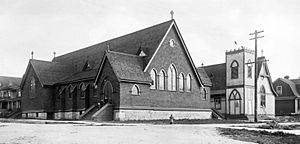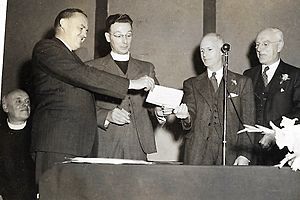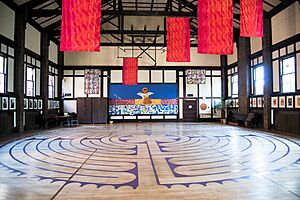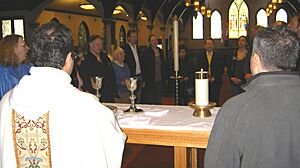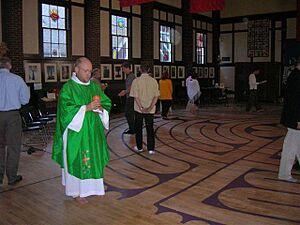St. Paul's Anglican Church, Vancouver facts for kids
Quick facts for kids St Paul's Anglican Church |
|
|---|---|
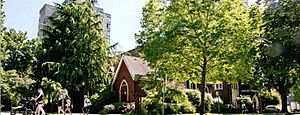
St Paul's church with the parish hall (right) and the Pendrellis apartment building (left), 2015
|
|
| Location | Vancouver, British Columbia |
| Country | Canada |
| Denomination | Anglican Church of Canada |
| Administration | |
| Deanery | Kingsway |
| Archdeaconry | Burrard |
| Diocese | New Westminster |
| Province | Ecclesiastical Province of British Columbia and the Yukon |
St. Paul's Anglican Church is a historic church in Vancouver, British Columbia, Canada. It serves the downtown areas of the West End and Yaletown. It is one of the oldest Anglican churches in Vancouver. St. Paul's grew from an even older church called St. James, which was the first Anglican church in the city.
Contents
A Look Back: Early History
Building the Church
The Anglican Parish of St. Paul started when Vancouver was growing very fast. A group of people from St. James Church wanted a new church closer to them. So, in 1889, a piece of land was bought, and a new church was built. The parish officially began in 1891.
The first church building was moved in 1898. It was placed on large skids and pulled by horses to a new spot. This moved it away from the noisy railway yards and closer to where most people lived. In 1905, a bigger, new church was built. The old church then became the parish hall, a place for community events.
The new church was built in a style called Gothic revival. This means it looked like traditional English churches with pointed windows and doors. This style was familiar to many people at the time.
The church has many beautiful windows. Some of the oldest ones show pictures from the Bible. Later, between 1952 and 1964, nine more windows were added with stained glass. These new windows all showed scenes of Jesus Christ.
The church also has a large pipe organ. It was built by a company called Casavant Frères from Québec. People say it was the first pipe organ built west of the Rocky Mountains.
Over the years, the church property changed. The old parish hall was replaced in 1911. A building for the rector (the main priest) was also built. In 1929, this building was moved to make the hall even bigger. Today, the church property looks much like it did then, with a ramp added in 2002 for easier access.
During the 1930s, the church faced money problems because of a big economic downturn. But after the Second World War, things got better. In 1945, the church celebrated by burning the mortgage papers for the parish hall. This meant they had finally paid off their debt!
In the 1960s, the church wanted to build a parking lot. But the city of Vancouver had other plans. Instead, the church built a tall apartment building called The Pendrellis. It opened in 1973 and provided affordable homes for seniors. This building later helped the church fund its important community programs.
Church Leaders and Activities
Many rectors have led St. Paul's Church over the years. Harold King was the longest-serving rector, from 1914 to 1944. Some rectors, like Adam de Pencier and Godfrey Gower, later became bishops.
From the beginning, St. Paul's was a busy church. It served many middle-class families in the area. The church followed traditional Anglican services, like Holy Communion and Morning Prayer. They also had many activities for everyone. These included Sunday Schools for children, groups for ladies and men, and youth groups like scouts and guides.
Some changes in church practices were big news at the time. For example, when a cross was first carried in processions in 1931, some people disagreed. It was even more surprising when women joined the choir in 1933!
Modern Times: Changes After 1980
As St. Paul's approached its 100th birthday, the West End neighborhood of Vancouver had changed a lot. Many old family homes were replaced by apartment buildings. This meant more people lived in the area, and the community became much more diverse. The church realized it needed to connect with these new residents.
In 1985, David Crawley became the new rector. He started important changes to how the church served the community and how it held its worship services.
New Ways to Help the Community
One of the biggest changes was reaching out to people who felt left out. Many people were facing health challenges at the time. David Crawley and his assistant, Neil Gray, opened the church to the wider community. They worked with other groups like St. Paul's Hospital to offer support. Crawley later said that St. Paul's had "regained its soul" by helping others.
Neil Gray continued this work. He helped the church become a place that welcomed and supported all people. In 1995, St. Paul's opened an Advocacy Office. This office helps people with problems like government benefits, housing issues, or immigration questions. Many volunteers, including people who are not church members, help thousands of clients each year.
St. Paul's also became known for its labyrinth. In 1997, a large, detailed copy of a famous medieval labyrinth from France was painted on the floor of the parish hall. This was the first permanent indoor labyrinth in Canada. People use the labyrinth for quiet walking and thinking. Thousands of people visit it every year, many of whom are not members of the church.
In 2008, a program called Our House West Coast Society was started by some church members. This program helped people recover from challenges. While not an official church program, St. Paul's members gave a lot of support to it.
Changes in Worship
Worship services at St. Paul's also changed over time. In 1981, the church started using a more modern language for its main service, called the Eucharist. By 1986, the Eucharist became the main Sunday morning service, replacing the older Morning Prayer service.
In 1986, the main altar was moved away from the wall. This allowed the priest to face the people during the service. A portable altar was also used, making services feel more personal and close.
New traditions were also introduced. These included using icons (religious images) and votive candles (small candles lit for prayer). The church also added a special place to keep the consecrated bread and wine for sick members. Practices like exchanging the Peace (greeting each other) and Washing of Feet on Maundy Thursday were also added. These changes helped people feel more involved in the service.
The labyrinth also became a place for worship. Services were regularly held on the labyrinth, making it an important part of the church's identity.
One of the most important changes was the role of women in the church. In 1976, women were allowed to become priests in the diocese for the first time. In 1982, a woman priest, Barbara Blakely, led a Eucharist service at St. Paul's for the first time. In 1990, Helen Patterson became the first woman appointed to the church's staff. And in 2013, Jessica Schaap became the first woman to be appointed as the main rector of St. Paul's.
Who Belongs to St. Paul's?
When the church was first built, going to church was a common practice. As Vancouver grew, so did the church's membership. In 1914, nearly a thousand people took communion at Easter, which was a way to count church members. The church even considered building a third, larger church because of the growing numbers, but it never happened.
Most of the early members were from British backgrounds. Until 1955, St. Paul's was part of the Church of England in Canada.
Since 1955, St. Paul's has been part of the Anglican Church of Canada. Over the years, like many churches, its membership numbers changed. However, the church became much more diverse. People from many different backgrounds, languages, and walks of life joined the community.
A famous film actress, Yvonne de Carlo, even sang in the choir when she was young!


